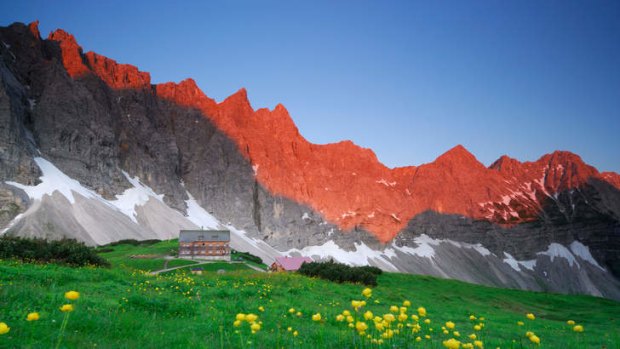
Range rover: The Karwendel range sits above the Falkenhuette alpine lodge.Credit: Alamy
Richard Tulloch laces up his trekking boots and eventually travels the road less life-threatening through the Austrian Alps.
Six of us are sitting on a comfortable patch of grass in Austria's Karwendel region, looking down on Innsbruck a thousand metres below us. We're still shaking slightly, thinking about the short section of track we've just crossed.
We were trying to negotiate a high mountain pass on a narrow path covered with treacherously loose scree, and suddenly found ourselves above a yawning abyss. We steeled ourselves to walk across it, hoping the route ahead would be less threatening. Instead, it looked even more dangerous. We stopped and sat down.

Hiking in the Karwendel range.Credit: Getty Images
Now we have to decide whether to press on or risk going back across that nasty section. We reassure each other that it may not be as bad as it looks. We're all experienced hikers. The return trip will be uphill, which will give our boots better grip and make balancing easier. We could probably cross it without stumbling nine times out of 10. But the consequences of one slip don't bear thinking about.
This is only day two of our trek. We have a week's route planned out and accommodation booked in mountain huts. If we don't cross the range today, we'll need to organise a new itinerary.
We've already tried to get over the mountains by other routes this morning, and seen that not everyone is as cautious as we are. At a col that we quickly rated impassable, we watched an Austrian couple rope themselves together with a flimsy bit of cord and set off down a steep, snow-covered slope. She had crampons on her boots, he didn't.
We didn't see how they fared, but we couldn't help noticing three plaques stuck on rocks at that point, memorials to Michael, Toni and Ernst, who no doubt also thought they'd be OK.
Some of my hiking friends have legs and nerves of steel. Others in our group, myself included, have legs that turn to jelly as they approach precipices and nerves of thin custard. Fortunately, our steely legged friends also have cool heads, and never push us to take risks we're not comfortable with.
We decide that turning back is the least worst choice. The footing over the chasm is indeed a little better climbing than descending, and we make it to solid ground. And hug each other.
Now we face a long hard afternoon, with a five-hour descent into the valley and a climb up the other side. At least the path will be wide. First we stop at a mountain hut for coffee and apple strudel with lots of whipped cream, pull out the maps and plan a new hike for the week.
It isn't difficult to find one. The Karwendel area has wonderful "wanderwege" (hiking trails) wandering all over the place. We choose a route that will take us mostly through valleys from the village of Scharnitz to the touristy town Pertisau. It won't be life-threatening, and it will still be a spectacular and challenging five-day trek.
Hiking trails around Innsbruck are generally well-maintained and signposted, with red spots indicating easier routes and black spots showing us the ones we now know to walk miles to avoid.
Our adjusted itinerary turns out to be brilliant. It takes us across rolling farmland and through dense forests of pine and larch. The rugged, rocky, snow-streaked peaks of the Alps tower above us. They're less intimidating when we're looking up at them rather than trying to find a way between them, but they're still awe-inspiring.
We follow fast-flowing rivers, fed by tumbling waterfalls. We occasionally step aside to let mountain-bikers pedal past us - at breakneck speeds going downhill, at barely walking pace struggling uphill on the rough tracks. We stop regularly at cafes to keep up our caffeine and apple strudel levels.
Towards the end of each day we make a stiff climb up to one of the huts that have been perched on vantage points by the German Alpenverein (Alpine Association).
Yes, we're still in Austria, but we're near the border, and the Germans have a habit of organising things for the rest of Europe these days. They do the huts well, with warm bunk-rooms, hearty meals and absurdly large beers available at reasonable prices. Life in the huts is jolly and communal. There are usually no showers, but we're all smelly friends together.
We find that we can comfortably cover about 15-25 kilometres each day, though in our planning we take more account of the vertical metres required. Up to 1000 metres of climbing is reasonably manageable for fit walkers; anything over 1500 metres feels like hard work.
At the end of the week we roll down into Pertisau, on the lovely lake known as the Achensee. Every house has geraniums in window boxes, elaborately carved wooden gables and typical Tyrolean painting around the window and door frames. Nearly every building is a hotel or guest house, trying to outdo its neighbours in the cuteness department, and there are very welcome hot showers.
Later in the week we read a shocking news report of five German climbers dying in the Swiss Alps. It leads me to research the statistics on hiking accidents. There are far too many tragedies. In the summer of 2010, there were 155 fatal accidents in the Austrian Alps alone - 10 of the victims were climbers, 10 were mountain-bikers and 81 were hikers like us; 80 per cent of the total were men.
Hiking at its best is a great, healthy activity, but it's a hobby, not something to risk your life for. Be very, very careful. Please.
THREE PERFECTLY SAFE THINGS TO DO IN INNSBRUCK
The Alpine Zoo
Europe's highest zoo specialises in animals from mountainous regions of the world. Entry €9 ($11). See alpenzoo.at.
Ambras Castle
The restored mediaeval castle of Ferdinand II displays art and weapons, as well as portraits of the Hapsburgs from 1400-1800. Entry €10. See innsbruck.info.
Nordketten Cable Car
A spectacular, effort-free and safe way to ride up the Nordketten Range and look out on the Karwendel region. €27 return. See nordkette.com.
FAST FACTS
Getting there Austrian Airlines has a fare to Innsbruck for about $2407 low-season return from Sydney and Melbourne including taxes. Fly to Bangkok (about 9hr with Thai Airways) and then Vienna (11hr 30min) and Innsbruck (50min); see austrian.com.
Staying there Beds in dormitories in Alpenverein huts cost about €20 ($25) a night. Add about €12 for dinner. See alpenverein.de. For accommodation in Innsbruck, including guided hiking packages, see innsbruck.info.
Further information Detailed maps and guidebooks are essential, as are good boots. See Mark Zahel's Karwendel-Rofan (in German but with maps) and an overview of the Scharnitz to Pertisau route in Jonathan Hurdle's Walking Austria's Alps: Hut to Hut.
Sign up for the Traveller Deals newsletter
Get exclusive travel deals delivered straight to your inbox. Sign up now.